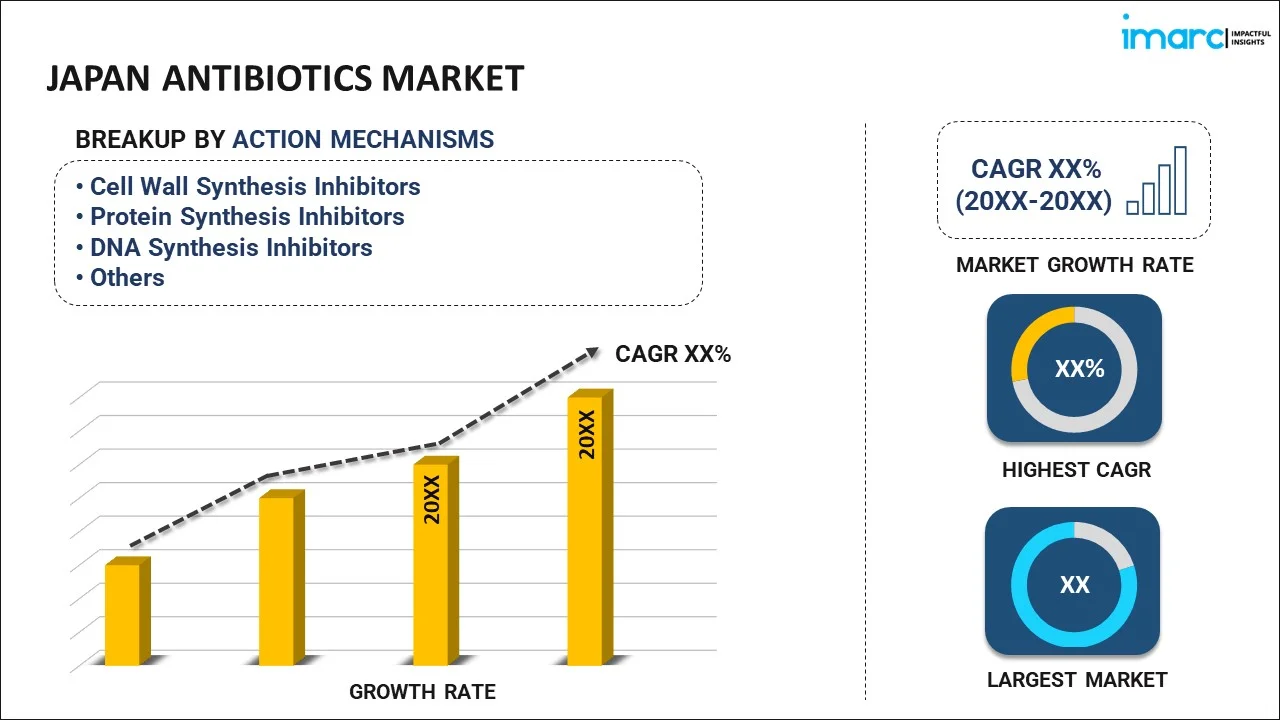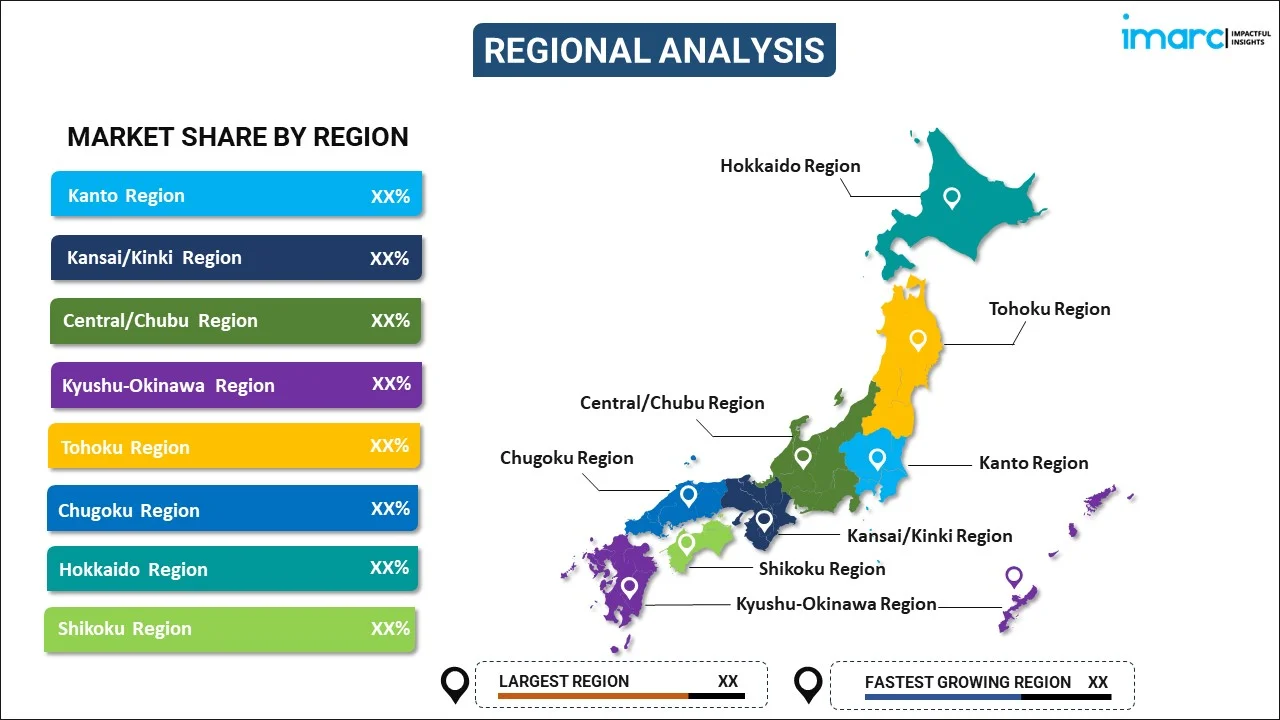
Japan Antibiotics Market Report by Action Mechanism (Cell Wall Synthesis Inhibitors, Protein Synthesis Inhibitors, DNA Synthesis Inhibitors, RNA Synthesis Inhibitors, Mycolic Acid Inhibitors, and Others), Drug Class (Cephalosporin, Penicillin, Fluoroquinolone, Macrolide, Carbapenem, Aminoglycoside, and Others), Spectrum of Activity (Broad-Spectrum Antibiotics, Narrow-spectrum Antibiotics), Route of Administration (Oral, Parenteral, Topical, and Others), End User (Hospitals, Specialty Clinics, and Others), and Region 2026-2034
Market Overview:
Japan antibiotics market size reached USD 3,375.8 Million in 2025. Looking forward, IMARC Group expects the market to reach USD 6,074.4 Million by 2034, exhibiting a growth rate (CAGR) of 6.75% during 2026-2034. The escalating prevalence of infectious diseases, which also leads to surgeries, medical procedures, and hospitalizations, thereby increasing the need for antibiotics to prevent and treat such conditions, is primarily driving the market.
|
Report Attribute
|
Key Statistics
|
|---|---|
|
Base Year
|
2025
|
|
Forecast Years
|
2026-2034
|
|
Historical Years
|
2020-2025
|
| Market Size in 2025 | USD 3,375.8 Million |
| Market Forecast in 2034 | USD 6,074.4 Million |
| Market Growth Rate 2026-2034 | 6.75% |
Antibiotics are powerful medications used to treat bacterial infections. They work by targeting and killing bacteria or inhibiting their growth. Antibiotics can be categorized into several classes, each with its unique mechanism of action. They are prescribed by healthcare professionals after diagnosing a bacterial infection. It's crucial to use antibiotics as directed and complete the prescribed course to ensure the complete eradication of bacteria. Failure to do so can lead to antibiotic resistance, where bacteria become less responsive to these drugs. While antibiotics are effective against bacteria, they do not work on viral infections like the common cold or flu. Overuse or misuse of antibiotics has raised concerns about the development of antibiotic-resistant strains of bacteria, making it essential to use them judiciously and only when necessary. Research into new antibiotics and alternative treatments continues to be a critical area of focus in healthcare to combat evolving bacterial threats.
Japan Antibiotics Market Trends:
The antibiotics market in Japan has witnessed significant growth over the years, and several key drivers have propelled this upward trajectory. Firstly, the rise in bacterial infections has necessitated an increased demand for antibiotics. Additionally, the expansion of the geriatric population, which is more susceptible to infections, has further fueled this need. Moreover, advancements in biotechnological methods have led to the discovery of novel antibiotics, thus expanding the market. Furthermore, the spread of antibiotic-resistant pathogens has created an urgency to invest in R&D, leading to more innovations and developments in the sector. Notably, the increasing support and funding from both government and private entities have been pivotal in pushing forward research initiatives. Another crucial factor is the growing awareness among people about bacterial infections and their implications, coupled with easy access to healthcare facilities. Consequently, there is a steady growth in antibiotic prescriptions, boosting the market. On the other hand, though the need for effective treatment regimens is undeniable, there are concerns about antibiotic overuse, potentially causing resistance. Nevertheless, the overall need for effective antibacterial treatments remains paramount, and these market drivers play a crucial role in shaping the industry's landscape.
Japan Antibiotics Market Segmentation:
IMARC Group provides an analysis of the key trends in each segment of the market, along with forecasts at the country level for 2026-2034. Our report has categorized the market based on action mechanism, drug class, spectrum of activity, route of administration, and end user.
Action Mechanism Insights:

- Cell Wall Synthesis Inhibitors
- Protein Synthesis Inhibitors
- DNA Synthesis Inhibitors
- RNA Synthesis Inhibitors
- Mycolic Acid Inhibitors
- Others
The report has provided a detailed breakup and analysis of the market based on the action mechanism. This includes cell wall synthesis inhibitors, protein synthesis inhibitors, DNA synthesis inhibitors, RNA synthesis inhibitors, mycolic acid inhibitors, and others.
Drug Class Insights:
- Cephalosporin
- Penicillin
- Fluoroquinolone
- Macrolide
- Carbapenem
- Aminoglycoside
- Others
A detailed breakup and analysis of the market based on the drug class have also been provided in the report. This includes cephalosporin, penicillin, fluoroquinolone, macrolide, carbapenem, aminoglycoside, and others.
Spectrum of Activity Insights:
- Broad-Spectrum Antibiotics
- Narrow-Spectrum Antibiotics
The report has provided a detailed breakup and analysis of the market based on the spectrum of activity. This includes broad-spectrum antibiotics and narrow-spectrum antibiotics.
Route of Administration Insights:
- Oral
- Parenteral
- Topical
- Others
A detailed breakup and analysis of the market based on the route of administration have also been provided in the report. This includes oral, parenteral, topical, and others.
End User Insights:
- Hospitals
- Specialty Clinics
- Others
The report has provided a detailed breakup and analysis of the market based on the end user. This includes hospitals, specialty clinics, and others.
Regional Insights:

- Kanto Region
- Kansai/Kinki Region
- Central/ Chubu Region
- Kyushu-Okinawa Region
- Tohoku Region
- Chugoku Region
- Hokkaido Region
- Shikoku Region
The report has also provided a comprehensive analysis of all the major regional markets, which include Kanto Region, Kansai/Kinki Region, Central/ Chubu Region, Kyushu-Okinawa Region, Tohoku Region, Chugoku Region, Hokkaido Region, and Shikoku Region.
Competitive Landscape:
The market research report has also provided a comprehensive analysis of the competitive landscape. Competitive analysis such as market structure, key player positioning, top winning strategies, competitive dashboard, and company evaluation quadrant has been covered in the report. Also, detailed profiles of all major companies have been provided.
Japan Antibiotics Market Report Coverage:
| Report Features | Details |
|---|---|
| Base Year of the Analysis | 2025 |
| Historical Period | 2020-2025 |
| Forecast Period | 2026-2034 |
| Units | Million USD |
| Scope of the Report | Exploration of Historical and Forecast Trends, Industry Catalysts and Challenges, Segment-Wise Historical and Predictive Market Assessment:
|
| Action Mechanisms Covered | Cell Wall Synthesis Inhibitors, Protein Synthesis Inhibitors, DNA Synthesis Inhibitors, RNA Synthesis Inhibitors, Mycolic Acid Inhibitors, Others |
| Drug Class Covered | Cephalosporin, Penicillin, Fluoroquinolone, Macrolide, Carbapenem, Aminoglycoside, Others |
| Spectrum of Activities Covered | Broad-Spectrum Antibiotics, Narrow-spectrum Antibiotics |
| Route of Administrations Covered | Oral, Parenteral, Topical, Others |
| End Users Covered | Hospitals, Specialty Clinics, Others |
| Regions Covered | Kanto Region, Kansai/Kinki Region, Central/ Chubu Region, Kyushu-Okinawa Region, Tohoku Region, Chugoku Region, Hokkaido Region, Shikoku Region |
| Customization Scope | 10% Free Customization |
| Post-Sale Analyst Support | 10-12 Weeks |
| Delivery Format | PDF and Excel through Email (We can also provide the editable version of the report in PPT/Word format on special request) |
Key Questions Answered in This Report:
- How has the Japan antibiotics market performed so far and how will it perform in the coming years?
- What has been the impact of COVID-19 on the Japan antibiotics market?
- What is the breakup of the Japan antibiotics market on the basis of action mechanism?
- What is the breakup of the Japan antibiotics market on the basis of drug class?
- What is the breakup of the Japan antibiotics market on the basis of spectrum of activity?
- What is the breakup of the Japan antibiotics market on the basis of route of administration?
- What is the breakup of the Japan antibiotics market on the basis of end user?
- What are the various stages in the value chain of the Japan antibiotics market?
- What are the key driving factors and challenges in the Japan antibiotics?
- What is the structure of the Japan antibiotics market and who are the key players?
- What is the degree of competition in the Japan antibiotics market?
Key Benefits for Stakeholders:
- IMARC’s industry report offers a comprehensive quantitative analysis of various market segments, historical and current market trends, market forecasts, and dynamics of the Japan antibiotics market from 2020-2034.
- The research report provides the latest information on the market drivers, challenges, and opportunities in the Japan antibiotics market.
- Porter's five forces analysis assist stakeholders in assessing the impact of new entrants, competitive rivalry, supplier power, buyer power, and the threat of substitution. It helps stakeholders to analyze the level of competition within the Japan antibiotics industry and its attractiveness.
- Competitive landscape allows stakeholders to understand their competitive environment and provides an insight into the current positions of key players in the market.
Need more help?
- Speak to our experienced analysts for insights on the current market scenarios.
- Include additional segments and countries to customize the report as per your requirement.
- Gain an unparalleled competitive advantage in your domain by understanding how to utilize the report and positively impacting your operations and revenue.
- For further assistance, please connect with our analysts.
 Request Customization
Request Customization
 Speak to an Analyst
Speak to an Analyst
 Request Brochure
Request Brochure
 Inquire Before Buying
Inquire Before Buying




.webp)




.webp)












